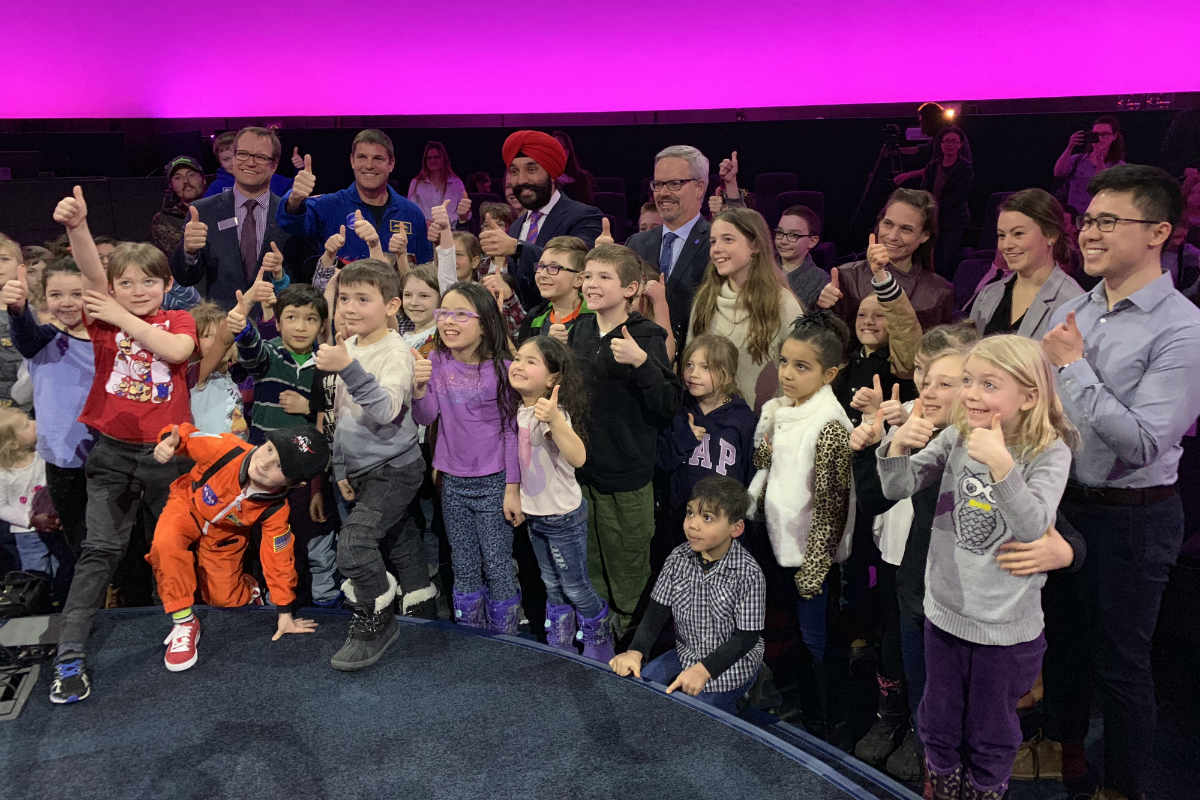
Students and UAlberta space researchers gather with guests from the federal government after the Honourable Minister Navdeep Bains, Minister of Innovation, Science and Economic Development, unveiled the federal government's national space strategy, Exploration, Imagination, Innovation: A New Space Strategy for Canada, at the Telus World of Science, Edmonton, March 6.
That was the sentiment put forth by an assembly of U of A space researchers after Navdeep Bains, Minister of Innovation, Science and Economic Development, unveiled the federal government's national space strategy, Exploration, Imagination, Innovation: A New Space Strategy for Canada, at the Telus World of Science, Edmonton, March 6.
During the festivities that included sentiments from Canadian astronaut Jeremy Hansen, Bains echoed his government's Feb. 28 announcement of a $1.9-billion investment over 24 years for the next generation of smart, AI-powered space robotics for the U.S.-led Lunar Gateway-the first space station to orbit the moon.
"By aiming for the moon, we allow our children to reach for the stars. Space represents limitless possibilities and endless discoveries. For every astronaut we send to space, there are thousands of Canadians who are part of the journey," said Bains.
That investment will include $150 million over five years for the Lunar Exploration Accelerator Program (LEAP), as well as the development of a smart robotic system and Canadarm3.
Ian Mann, professor and space physicist in the Faculty of Science, said the federal government"s release of the Canadian Space Strategy is a long overdue recognition of the strategic importance of space to Canadian interests. Whether it be developing technologies and services to exploit space to meet the needs of Canadians, monitoring and addressing the challenges associated with climate change, providing Canadian leadership in space exploration research, or ultimately in creating Canadian jobs in the new space industry.
Canada's space sector currently employs 10,000 highly skilled workers, generates $5.5 billion in Canada's economy annually, and averages $2 billion in export sales. With the new expansion of commercial exploitation of space, the industry is expected to grow very significantly over the coming years.
"The University of Alberta has active research programs in space exploration, and we will be looking to partner with the Canadian Space Agency and our international colleagues to unlock the secrets of the universe and train the next generation of scientists and engineers in a space environment," said Mann, who currently has two CSA-funded projects to develop the technology concepts to measure radiation outside the Lunar Gateway. "These space-savvy U of A trainees are perfectly placed to provide Canadian leadership in the new commercial space race", he added.
The U of A's list of space accomplishments includes creating weather-measurement tools for the Phoenix lander that conducted habitability experiments on the red planet in 2008; planetary geologist Chris Herd, who attended the announcement, is involved in planning for a sample-return mission that would go to Mars; and AlbertaSat, the U of A team which built and launched a small cube satellite to measure space weather in 2017.
Bains referenced the original Canadarm-helped built by U of A engineering alumni Lloyd Pinkney and Garry Lindberg-asserting that the precision technology used in Canada's most renowned contribution to the space program is now being used by surgeons around the world.
Nick Yee, a U of A medical student and space enthusiast who spoke at the event alongside Bains, Hansen, and CSA President Sylvain Laporte, said he is excited about the medical advancements waiting among the stars.
"Thankfully we have a lot of bright people, engineers, medical doctors and scientists, out there [in space] bringing new technology to monitor health here on Earth," he said.
Yee was joined on stage by fellow UAlberta student Casia MacLeod, an aspiring engineer who has had her eyes set on the skies since she was a child. MacLeod told the audience that she sees the new national space strategy as a way to leverage her experience on the AlbertaSat project into even an even bolder direction using space-based radar for Earth observation.